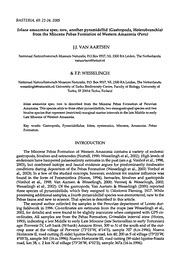
Iolaea amazonica spec. nov., another pyramidellid (Gastropoda, Heterobranchia) from the Miocene Pebas Formation of Western Amazonia (Peru) PDF
Preview Iolaea amazonica spec. nov., another pyramidellid (Gastropoda, Heterobranchia) from the Miocene Pebas Formation of Western Amazonia (Peru)
BASTERIA, 69:21-24, 2005 Iolaeaamazonicaspec. nov.,anotherpyramidellid (Gastropoda, Heterobranchia) fromthe MiocenePebas Formationof WesternAmazonia(Peru) J.J.van Aartsen Nationaal Natuurhistorisch MuseumNaturalis,P.O.Box9517,NL2300RALeiden,TheNetherlands; [email protected] &F.P. Wesselingh Nationaal Natuurhistorisch MuseumNaturalis,P.O.Box 9517,NL2300RALeiden,TheNetherlands; [email protected];UniversityofTurkuBiodiversityCentre,Faculty ofBiology,University of Turku,SF20014Turku,Finland Iolaea amazonica spec. nov. is described from the Miocene Pebas Formation of Peruvian Amazonia.Thisspeciesaddstothreeotherpyramidellids,two mesogastropodspeciesandtwo bivalve speciesthatrepresent(restricted)marginalmarineintervalsinthe lateMiddletoearly Late MioceneofWesternAmazonia. Key words: Gastropoda, Pyramidellidae, Iolaea, systematics, Miocene, Amazonia, Pebas Formation. INTRODUCTION The Miocene PebasFormationof Western Amazonia contains a variety ofendemic gastropods, bivalvesandostracodes(Nuttall, 1990;Wesselingh etal.,2002).Highlevelsof endemismhavehamperedpalaeosalinity estimates in thepast (seee.g.Vonhofetal., 1998, 2003), but combinedisotope and faunalevidence argues forpredominantly freshwater conditionsduring deposition of thePebas Formation(Wesselingh etal., 2002;Vonhof et al., 2003). Ina fewof the studiedoutcrops, however,evidence formarine influencewas foundin the form of Foraminifera (Hoorn, 1994),barnacles, bivalves and gastropods (Vonhof et al., 1998; Van Aartsen & Wesselingh, 2000; Vermeij & Wesselingh, 2002; Wesselingh et al., 2002). Of the gastropods, Van Aartsen & Wesselingh (2000) reported threespecies of pyramidellids, which they assigned to OdostomiaFleming, 1817. While processing additionalsamples, afourthpyramidellid species wasencountered,newtothe Pebasfaunaandnewtoscience. Thatspecies is describedin thisarticle. The secondauthorcollectedthesamples in thePeruvian department ofLoreto dur- ing fieldwork in 1996.Co-ordinatesare estimatesfromthe maps(see Wesselingh etal., 2002,for details)andwere foundtobe slightly inaccuratewhencompared withGPS co- ordinates.All samples are from the Pebas Formation, Grimsdalea interval zone (Hoorn, 1993),indicating alateMiddletoearlyLateMiocene(late SerravalliantoearlyTortonian) age:PorvenirIV,Leftbank(W-bank) AmazonRiver, 300m Nofthesouthend oftheout- crop zone at the village of Porvenir (73°23'W, 4°14'S), sample 707 (6.ix.l996); Nuevo HorizonteII, roadcutting (E-side) Iquitos-Nauta road,km 40, 200m Sofvillage(73°25'W, 4°05'S), sample365(16.ix.1996); NuevoHorizonteIII, roadcutting (W-side) Iquitos-Nauta road,km 38,c. 2km Nofvillage (73°26'W, 4°02'S), sample 367a(16.ix.1996). 22 BASTERIA, Vol. 69,No. 1-3,2005 Theshells are deposited the Divisionof Cainozoic Mollusca, NationaalNatuurhis- torisch Museum Naturalis, Leiden, The Netherlands (formerly Rijksmuseum van Geologie enMineralogie), abbreviatedRGM, and in thecollectionsof theINGEMMET, SanBorja,Lima,Peru.Thenumberofspecimens is indicatedbehindthebar. Abbreviationsusedin shell descriptions: H, height; W, width; Hap, height ofaper- ture. SYSTEMATICS Iolaea amazonica spec. nov. (figs 1-3) Type material. - Holotype: Porvenir IV,level F707 (RGM456800; fig. 1). Paratypes:typelocality (RGM 456801/1[fig. 2], RGM456802/14;INGEMMETwithout number/1 [fig. 3]; Nuevo Horizonte II, levelF365 (RGM456803/1);Nuevo Horizonte III,level 367a (RGM456804/2). Diagnosis. - Shellnearlycylindrical, withfourpronounced spiralribs andconspicu- ously thickened,sinuategrowthlines. Description. - Shellwithfourteleoconchwhorls. The embryonic whorls areintorted and cannot be detectedat theapex. The teleoconchwhorlsincrease only very slowly in size and areseparated by amarkedly incisedsuture. There are fourspiralribs ofabout equal strength whichstartimmediately afterthe endof the embryonic whorls, whichare smooth. Thespiralsareaboutasbroadas theinterspaces andboththeseaswellastheribs themselves are crossed by many thickened growthlines. These growthlines are not straightbut have aninverted-Sshape. Atthebaseoftheshellthereare threemorespirals. Theaperture isrelatively small,its height is approximately 1/3ofthe shellheight. A sinusislocatedattheadapical sideoftheouterlip corresponding withthefirstspiral rib, whichmaybe alittleless strongthantheother three.Theouter lip is not muchrounded andsmoothinside.The columellahas apronounced tooth.There isnoumbilicusbut in youngershellsaslight umbilicalchinkispresent. Becauseoftheintortedembryonic whorls, thethickened,sinuate growthlines as well asasmallbutconspicuous tooth weplace this newspecies in thegenusIolaeaA.Adams, 1867. Dimensions.- Holotype (fig. 1):H 1.80mm, W0.65 mm,Hap 0.60 mm;INGEMMET n.n.(paratype, fig.3):H 1.40mm, W0.63mm,Hap0.53 mm. Otherparatypes: H1.50-1.80 mm,W0.55-0.65 mm. Etymology. - NamedaftertheAmazon. Differentiation.- Iolaeaamazonicaspec.nov.doesnot resembleextantspecies known fromthePacificcoastofAmerica. Thethreespecies mentionedby Skoglund (1972:122), viz. I.amianta(Dall& Bartsch, 1907),I. delicatula(Carpenter, 1864)andI. eucosmia(Dall& Bartsch, 1909),all are bigger andmore conical. Iolaeaeucosmiais the mostslenderof the three,but itis still less slender thanI. amazonicaspec. nov. and moreover has only three spiralribsinsteadoffourontheteleoconchwhorlsof thespire. Nospecies of Iolaeahavebeenmentionedfromthe Caribbeancoasts or theAtlantic coastofSouthAmerica. Neitherdoauthorsworking onfossil faunas,likeJung (1969)for thePlioceneofTrinidador Weisbord(1962) forlatecenozoic gastropods fromVenezuela, mentionany species whichcouldbe compared withI.amazonica spec.nov. From the coasts of Suriname and Brazil, Miralda robertsoni is described by Van Regteren Altena(1975: 75,76, fig.30a,b).Thisspecies undoubtly belongs toIolaeaandhas acertainaffinitywithIolaeaamazonicaspec.nov. Ittooshows arathercylindrical shapebut isrelativelybroader.However,ithasonlythreespiralribs andalesswell developed tooth Van Aartsen & Wesselingh: lolaea amazonica spec, nov.,fromthe MiocenePebas 23 Figs 1-3.Iolaeaamazonicaspec. nov., from Porvenir IV,Loreto, Peru, level F707.1, RGM456800 (holo- type); 2,RGM 456801 (paratype);3, INGEMMET(paratype).Scalebar 100µm. onthecolumella Iolaeascitula(A. Adams,1860),thetype-species ofIolaea,was recently figuredbyHori, inOkutani(2000:729,pi.363fig. 165).AnotherJapanese species showing evenmoresim- ilaritiesto thenewspecies, viz. Iolaea neofelixoides (Nomura,1936),hasbeenfoundin the East Mediterraneanand is figured by Van Aartsen& Recevik (1998: 13, 14, fig.4). This species is nearly twice asbig as Iolaeaamazonica spec. nov. and hasonly threespiral ribs, contrary toIolaeaamazonicaspec.nov.whichhasfour. Remarks.- Iolaeaamazonicaspec. nov. hasbeenencounteredin samples containing a varietyofPebasianendemic cochliopine snail-andpachydontine bivalvespecies, butalso otherindicatorsofmarine influence,suchas Odostomia nuttallivanAartsen& Wesselingh, 2000,O. cotuhensisVanAartsen& Wesselingh, 2000,O. spec., Thaiswoodwardi(Roxo, 1924), Nassariusreductus Vermeij& Wesselingh,2002, Panamicorbulaspec,andMacomaspec, (see Vonhofet al., 1998). These samples are all located withinthe Grimsdalea intervalzone (Hoorn, 1993)indicatingalateEarly toearlyLateMiocene age(ca 10-12 Ma).These(peri) marinetaxa havenotbeenfoundin otherintervalswithinthePebasFormation. ACKNOWLEDGEMENTS WethankW.Renema(NNM,Leiden)for SEMphotographs, andE. Gittenberger for criticallyreading themanuscript. 24 BASTERIA, Vol. 69,No. 1-3,2005 REFERENCES AARTSEN,J.J.VAN,& M.RECEVIK, 1998.Two moreIndo-PacificspeciesfoundintheMediterranean. - La Conchiglia 30(286): 13-15. AARTSEN, J.J VAN, & F.P. WESSELINGH, 2000. New Odostomia species (Gastropoda, Heterobranchia, Pyramidellidae) fromtheMiocenePebasFormationofWesternAmazonia(Peru,Colombia).- Basteria 64:165-170. ALTENA,C.O. VAN REGTEREN, 1975.The marineMolluscaofSuriname(DutchGuiana).Holocene and recent. Part3.GastropodaandCephalopoda.- ZoologischeVerhandelingen139:1-104. HOORN,C.,1993.Marineincursions andtheinfluence ofAndeantectonics ontheMiocenedepositionalhis- tory of northwestern Amazonia: Results of a palynostratigraphic study. - Palaeogeography, Palaeoclimatology,Palaeoecology 109:1-55. JUNG,P.,1969.Miocene andPliocene mollusks fromTrinidad.- BulletinsofAmericanPaleontology55(247): 293-657. NUTTALL, C.P., 1990. Areview ofthe Tertiarynon-marinemolluscan faunas ofthe Pebasian and other inland basins ofnorth-western SouthAmerica. - Bulletin ofthe BritishMuseum ofNatural History (GeologySeries)45(2): 165-371. OKUTANI,T.(ed.),2000. MarinemollusksinJapan:i-xlviii,1-1173.Tokyo. SKOGLUND,C., 1992.Additions tothePanamicProvince gastropod(Mollusca)literature: 1971-1992. - The Festivus24(Supplement):i-viii, 1-169. VERMEIJ,G.J.,&F.P.WESSELINGH,2002. NeogastropodmolluscsfromtheMiocene ofWesternAmazonia, withcommentsonmarinetofreshwatertransitionsinmolluscs. - JournalofPaleontology76(2):65-70. VONHOF, H.B.,F.P. WESSELINGH& G.M. GANSSEN, 1998.- Reconstruction ofthe Miocene western Amazonian aquaticsystem using molluscan isotopicsignatures. - Palaeogeography,Palaeoclimato- logy,Palaeoecology141:85-93. VONHOF,H.B.,F.P.WESSELINGH,R.J.G.KAANDORP, G.R.DAVIES,J.E.VANHINTE,J.GUERRERO,M. RASANEN, L. ROMERO-PITMANN & A. RANCI, 2003. Paleogeography of Miocene Western Amazonia:Isotopiccompositionofmolluscan shells constrains theinfluence ofmarineincursions. - GSABulletin 115:983-993. WESSELINGH, F.P., M.E. RASANEN, G. IRION, H.B. VONHOF, R. KAANDORP, W. RENEMA, L. ROMERO POTMAN & M. GINGRAS, 2002. Lake Pebas: a palaeoecological reconstruction of a Miocene, long-livedlake complexinwesternAmazonia.- Cainozoic Research 1:35-81. WEISBORD, N.E., 1962. Late Cenozoic gastropods from Northern Venezuela. - Bulletins ofAmerican Paleontology42(193):1-672.
